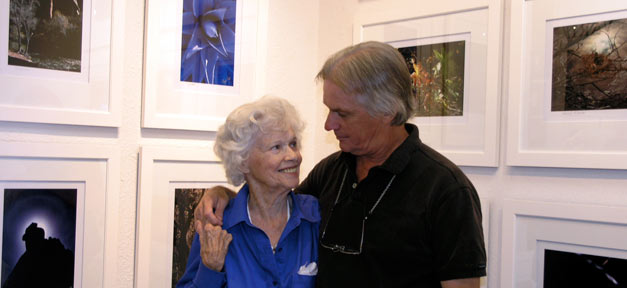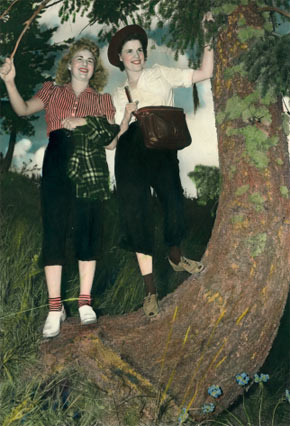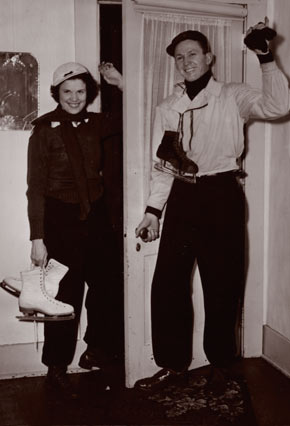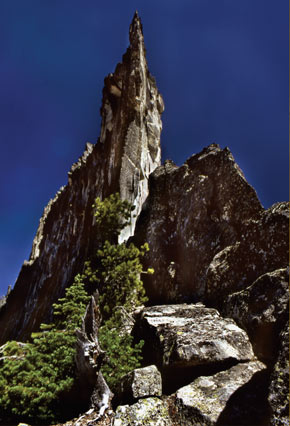
Hazel Hall and her son Dann pause at Hallans Gallery in front of a recent exhibit of the elder Hall’s photos.
Photo by Billie Jean Plaster
Dann and Hazel Hall
Mother and son bound by photographic artistry
By Sandy Compton
Dorothy Hazel Bridges was born March 26, 1913, in Kansas City, Kan. But, she says, “About the next week, we moved over to Kansas City, Mo., where my father had a greenhouse. I can smell the carnations yet.”
When Hazel – which she prefers to be called – was 5, the family moved to Montrose, Colo., and then to Delta. “Dad had got a job with the county to build up old farms that had gone back for taxes. They’d get into an old house, and Dad would build up the orchards. He was known as the best irrigator in the county – imagine that. He would always plant flowers when we went to a new place – he said flowers were God’s way of sharing love – and Mother would clean up those old houses.
“So, I can remember as a child moving all the time from one farm to the next – until we got to Paeonia. There we got a farm, and a few years later, they bought a home in Hotchkiss, which is where I graduated from high school.”

| This photo titled “Hazel Hiking” was taken by Ross Hall circa 1943 and hand tinted around the same time by Hazel. She and her hiking companion, Evelyn Thomas, were exploring a mountainside around Dover. Ross learned hand tinting in photography school and taught Hazel the method using transparent oils. She says she always wanted to be an artist and “that took its place.” Hazel still gets requests to hand color black-and-white photos. |
|
Hazel was a 16-year-old beauty packing peaches, “working in the fruit” she calls it, when a lanky fruit picker with a soft Texas drawl saw her in a Palisades, Colo., drugstore. “He just followed me out the door,” says Hazel, “and started whipping up a conversation. And that was it.”
It took him a couple of years to reel her in, but in January 1932, she and he stepped off a train into a cold winter night and a warm, small-town welcome and embarked on life together in Sandpoint as Mr. and Mrs. Ross Hall. They were a team, pouring energy and time into community, family and a photography business they would come to own. Over the next two decades, they built up Ross Hall Studios and had three children – Loyce, named for Ross’ twin sister, Robert Ross and Dann, who is now curator of the Ross Hall Collection, proprietor of Hallans Gallery on First Avenue and a photographer in his own right.
By the mid-1950s, Ross Hall Studios had become a Sandpoint fixture and Ross’ photographs were nationally known. But, Ross and Dann were not the only photographers in the family. Next to his classic prints, Hallans recently displayed a selection of Hazel’s photography. Hazel, at age 94, still has the bright eyes and sense of humor that made that long-ago fruit picker follow her out of the drugstore. Dann, about to turn 60, favors his Dad – tall, thin and laconic.
My first question: Why two n’s?
Hazel: (Dann laughs) Ask him. I didn’t name him that. His name was Danny Jay. He didn’t like “Danny,” so
he cut off the “y.” It’s even legal now, isn’t it?

| Hazel Hall took the photo above of horses feeding near a hillside around Sun Valley, Idaho, circa 1978, on one of their many vacations there. |
|
Dann: It’s legal now. I’ve squatted on the name long enough.
You didn’t name him that?
Hazel: Loyce named him that. I don’t know why she liked Jay, but she did.
I’m glad we’ve cleared that up. Hazel, all these pictures on display here today are color. I expected to see some black-and-white stuff from you.
Hazel: Well, all of those got lost – my black and white. They were in a big box, and it looked like there was just junk in there. Anyway, they got thrown out. These, they’re off of slides. I took all these when we were traveling. I’m the only one who took pictures when we were traveling. Ross took pictures of this county and this state, and over into Montana and Washington, but he rarely took pictures anywhere else.

| Hazel and husband Ross wave goodbye to their young children as they
depart for an ice skating date, circa 1945. Ross was the principle photo professional for
Sandpoint from at least 1931 to 1960, joined by Hazel in 1932. At one time, they had 100
employees and processed more than 600,000 large format negatives. They sold 35 million
postcards during the 1950s. His images continue to sell around the world. |
|
Ross didn’t take any pictures when you were traveling?
Hazel: He didn’t take any pictures. He said, “What will I do with them?”
Dann: Tahoe?
Hazel: That was an assignment from the postcard company. The same way with Yellowstone.
Dann: He didn’t take them in a tourist-like fashion, you mean.
Hazel: Yes.
Just a small family discussion, folks. (They both laugh) Let’s go on. So, when you lost all your black-and-white work – was it a fire, were you cleaning out the attic?
Hazel: Yes, I just threw them all in a box and took it over to an office that Bob and Dann had, and it got lost. There was a lot of family pictures in there, which made me sad, but there wasn’t much else good in there, I don’t imagine.
When did you take your first picture?
Hazel: Ross bought me – before we were married – a little 116-size camera, and most of the pictures that got thrown away were taken by that camera. It had adjustments, and you had to do all the calculations. You couldn’t tell the difference between what I took and what Ross took many times. In fact, “Syringa Time,” which was our best seller for ages, I took that picture, and when we got home and developed it, Ross said. “Where did you get that? Take me back there.” So, he goes back and takes the picture.

| Dann Hall was traveling in Connemara, Ireland when he took the image above entitled “Hillside Shepherd,” circa 1998. |
|
Dann: Large format.
But you saw it first.
Hazel: That’s right. (She laughs) I saw it first.
Dann, when did you take your first picture?
Dann: When I was 3, with a little Brownie snapshot camera. I left the front porch, and by the time I’d reached the corner 300 feet away, I’d taken 12 shots of the sidewalk.
A study in concrete.
Hazel: I wish you had them now. It would be kind of fun to see what the pattern is.
Dann: That’s kind of how the show at the Pend d’Oreille Winery was – 20 shots in 20 minutes.

| Tthe knife-like edge of Chimney Rock's south face stands out in sharp contrast to the blue sky over the Selkirk Mountains, in this circa 1982 photo by Dann. |
|
Hazel: Of what?
Dann: Of the old Humbird Mill. Those were all done with a little point-and-shoot digital. Still looking down, most of them.
At concrete, too. Hazel, do you still take pictures?
Hazel: Honestly, what I’ve done is I buy these little ready-set cameras. Don’t have to do anything but just “ta-chit,” (she makes the sound of a camera shutter) and I’ve gotten some good pictures.
So how many pictures do you think you’ve taken in your life?
Hazel: Oh, my goodness. Don’t ask me.
Tens of thousands?
Hazel: Oh, no! I don’t have any estimate at all.
How about you, Dann?
Dann: Oh, in the low thousands, I’d guess.
You’re a little more deliberate than many photographers. You wait for light. You don’t take all your pictures, 20 in 20 minutes.
Dann: No. That’s the other end of how I usually set photographs. Most of my stuff, whether it’s commercial shots or travel, will be tripodded, using a 4 by 5. It’s kind of a slow-motion process.

| “The Ruins at Twilight” by Dann Hall |
|
What’s the longest you have ever waited for a picture?
Dann: Probably, it was with Dad. Three hours when I was 4 years old, and when you’re 4 years old, three hours is like 50 years. It was over on Gold Hill, waiting for the clouds to drift into the right position over City Beach, which is where I really wanted to be, over playing on the swings.
We’re running out of space. Hazel, what else would you like to say?
Hazel: I taught Verna Mae Davis how to hand tint, and she colored a lot of pictures. We still see each other all the time, and she says that Duane (her husband, late photographer Cap Davis) had opportunities to move other places, and he didn’t want to because he liked Sandpoint. She says “I’ve never gotten over thanking him for not going someplace else.” And I feel the same way. Ross had opportunities in Butte and a couple of places on the Coast, but he didn’t, and I’ve thanked him many times.
Sandpoint is grateful, too. Hazel.
|